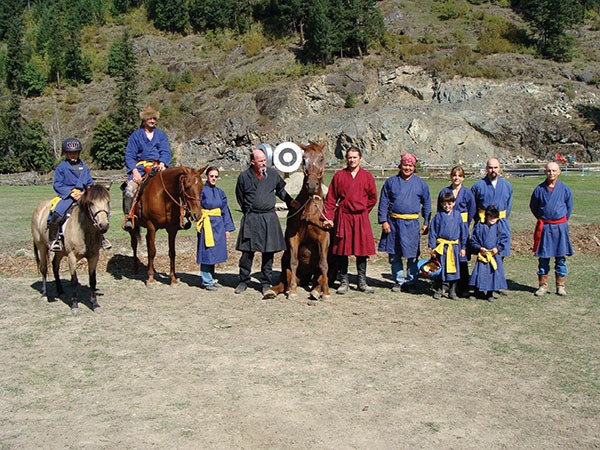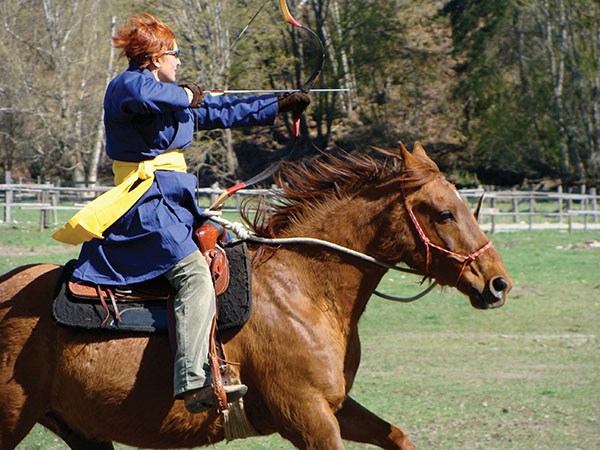Before you could say, “hold your horses,” three arrows hit the centre of the straw archery target 20 metres away. In the moments prior, a pair of Borsos Torzs archers removed bows and arrows from the back of a silver Dodge Ram. They efficiently strung the weapons and arranged a dozen arrows in the same hand in which they grasped their bows. They then stepped forward and released a torrent of arrows towards the distant target.
Robert Borsos founded Borsos Torzs Horse Archery Club of Mount Currie. He and member Alvin Nelson were practicing their bow skills in anticipation of the first horseback archery competition to take place in Squamish. Their training session took place in the middle of the field at Diamond Head Ranch on Squamish Valley Road where the competition will be hosted this weekend.
“I had a dream that I was cantering with a horse and shooting a bow,” explained Borsos. “The next day, right away, I phoned up both the Squamish and Pemberton stables. One guy from Pemberton, Cowboy Bob, he said, ‘OK, I’ll teach you how to ride.’ January 4, 2003 – that was the first time I sat on a horse.”
Borsos became enchanted with the activity when he saw a demonstration while visiting his family in Hungary.
“What I saw, it was unbelievable,” he said. “I decided I would pick up this sport.”
Twelve years later, Borsos is the Törzsfo, or leader of the Borsos Torzs Horse Archery Club. His life is focused on training and competing. In the summer, when he’s not travelling to teach or compete, he practices daily: riding every morning and most evenings. In the winter, Borsos works in Whistler as a shiatsu therapist to earn money in order to follow his passion during the season.
The Borsos Torzs have 40 members, 14 of whom compete regularly. The Hungarian word “Torzs” means tribe and so the Borsos Torzs are Robert’s tribe. The group has been meeting regularly to practice since 2003 and in 2006 they became an officially recognized chapter of the Kassi Horsearchery School – the organization that oversees and regulates horseback archery competitions and schools around the world.
After several centuries of disuse, the tradition of horseback archery is undergoing a renaissance.
In antiquity, it was a technique of war in Japan, South America, Eastern Europe, and notably by the Huns, Mongols and Turks. In North America, horseback archery was used most commonly in the prairies, where open terrain favoured travel by horse.
Mounted archers were often used as hit-and-run cavalry for skirmishing and harassing the enemy, with some civilizations outfitting these troops with armour to be deployed in a more unified fashion.
The development of modern firearms eventually rendered horseback archery obsolete and the culture disappeared for a time.

Kassai Lajos of Hungary is credited with sparking the resurgence of the tradition by devising a school, competitions and a system for training. He worked as a bow maker and competed in field archery before turning his attention to horseback archery in the late 1980s. The epicentre of this resurgence is in Lajos’s home in Naposvár, Hungary.
Presently, there are 17 schools subscribing to Lajos’s methodology: eight in Hungary and nine in other countries in Europe and North America.
Official competition events are set up with a 99 metre track and a target set nine metres away from the horses path. Points are awarded based on accuracy and speed of completion. Students are able to move through 10 levels from beginner to expert.
Progression is granted based on completion of exams and by achieving certain scores at sanctioned events. The fundamental elements like breathing and form in archery, and riding must be proven before students can advance. As they progress, students are rewarded with different coloured robes and sashes which display their level.
At the world cup in Kaposmero Hungary in July, Borsos managed to score 155 points, ranking him 16th. The winner, Lajos, scored 297 points. For perspective, a person with rudimentary skills in archery and riding, but who has never combined the two, might score 30 points in such a competition. Archery and equestrian require co-ordination, poise and focus in their own right; the fusion of these two activities compounds the difficulties. The result though, is impressive.
Borsos conveys the difficulty of learning this forgotten tradition and attaining
a proficiency.
“I had to do all the exams in Hungary: shooting bareback more than 90 points,” he said. “It was really, really hard training. It cost me a lot of money and a lot of pain. I did all the exams so I can start my own tribe or Tersh in Canada.”
This summer, Borsos travelled to Hungary, Montana, Toronto and Vancouver. After the Squamish event, he is taking off to a competition in Kuala Lumpur, Malaysia, followed by another in South Korea.
The Mount Currie Club is looking to expand and hold more sanctioned competitions in Edgewater and Squamish. Presently, the regulations allow one team to host only two competitions each year.
Alvin Nelson of The Lil’wat Nation and a member of the Borsos Torz became involved in horseback archery when he went to a local competition to support his daughter who was participating. Even though she has stopped, Nelson continues the practice.
“Now, I’m usually placing like fourth or fifth,” he said. “When I first started, I was always last.”
He remarked on the importance of the relationship and communication between the horse and the rider.
“If you have a horse that’s going too fast, it’s pretty hard to get an arrow off because your whole body is moving,” he said. “Part of the training is making the track in 11 seconds. If you have a horse that’s making the track in six or seven seconds, you’re lucky to get one or two shots off.”
When competitors travel to other events, they have to ride a horse with which they have had no previous experience. Alvin said that it isn’t too difficult, so long as the horse has been trained. In the spirit of sportsmanship he said, “if other archers come to our tournament, we try to give them the best horse for them.”
The event this weekend at Diamond Head Ranch is being held in conjunction with the Mount Currie and Squamish Nation Drummers and Dancers. Historically, indigenous groups of this area practiced mounted archery, though it was not as prominent as it was with groups further to the interior.
“For me it’s like a modern sport in a way, even though it’s an old tradition. It’s 2,000 years old. We had bows in Lil’wat Territory and also in Squamish Nation,” commented Nelson. “Might not be exactly Lil’wat or Squamish,” said Nelson, gesturing to the bow he held. “It is still a bow. We used to have quite a small bow in our area and we could still kill a moose with it. It’s a practice (making bows) that’s going to have to come back, eh?
“It would be nice if they could have a tournament here every year,” he said. “Gives us another tournament to go to. We’re from Lil’wat. Coming into the Squamish Nation Territory, it will be nice to meet some of them again.”



